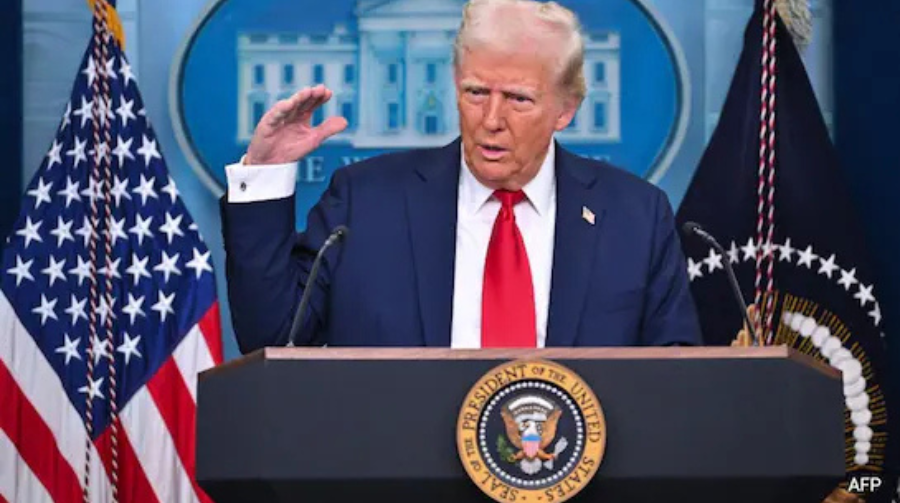News
Trump Imposes Tariffs on India to End Russia-Ukraine War, Says White House
In a dramatic move that has stirred global markets and diplomatic circles, the White House confirmed that U.S. President Donald Trump has imposed fresh tariffs on India, citing the need to pressure Moscow into ending the ongoing Russia-Ukraine war.
Speaking at a press briefing on Tuesday (August 19, 2025), White House Press Secretary Karoline Leavitt said the U.S. President is using sanctions and trade measures “as powerful leverage” to bring the war to a close. The announcement has deepened tensions between Washington and New Delhi, coming just days after U.S. Treasury Secretary Scott Bessent accused India of “profiteering” by reselling Russian oil.

White House: Tariffs Meant to Force Moscow’s Hand
“The President has put tremendous public pressure to bring this war to a close. He has taken actions, including sanctions on India, and made it clear that he wants to see this war end,” Leavitt told reporters.
The new tariffs amount to 50% on Indian exports to the U.S., including a 25% levy specifically tied to India’s purchases of Russian crude oil, which comes into effect on August 27. According to officials, the move is designed to disrupt what Washington views as India’s growing role in keeping Moscow’s war machine afloat through energy revenues.
India’s Russian Oil Imports Under Scrutiny
Treasury Secretary Scott Bessent, speaking earlier on CNBC, drew a sharp comparison between China and India’s energy policies.
- China: Oil imports from Russia have risen only 3% since the Ukraine war began, from 13% pre-war to 16% now.
- India: Imports have skyrocketed from less than 1% before 2022 to nearly 42% of total oil imports today.
“India is just profiteering,” Bessent alleged. “They’re buying cheap Russian oil, refining or reselling it, and making around $16 billion in excess profits. This arbitrage sprung up only during the war—it’s unacceptable.”
Critics note that Washington has so far been more lenient on Beijing’s imports, citing China’s “diversified inputs,” while India faces disproportionate pressure, something New Delhi has described as “unjustified and unreasonable.”
Strain in U.S.-India Relations
The tariffs have triggered unease in New Delhi, which has consistently defended its energy trade with Moscow as a matter of national interest and economic security. India’s Ministry of External Affairs has stated that energy diversification is essential and that “no foreign government has the right to dictate India’s sovereign decisions on oil sourcing.”
International analysts warn that Trump’s move could strain ties with one of Washington’s key Indo-Pacific partners, especially at a time when the U.S. is also navigating tense relations with China and Russia.
Trump’s Claim: Ending the India-Pakistan Conflict
In a surprising twist, the White House also credited President Trump with brokering peace between India and Pakistan, claiming his trade policies and diplomatic interventions averted a potential nuclear escalation.
Leavitt said Trump’s leadership had helped close “seven global conflicts,” including the long-standing hostility between New Delhi and Islamabad.
“We’ve seen it with the end of the conflict between India and Pakistan, which could have resulted in a nuclear war if we had not had a President who believed in the strength and leverage that comes with the job,” Leavitt told reporters.
Trump himself has repeatedly claimed that a Washington-mediated ceasefire ended recent border hostilities between India and Pakistan, boasting that he “helped settle” tensions over 40 times since May.
India’s Response: Denial of U.S. Mediation
However, India has firmly denied any U.S. role in ending the conflict. Prime Minister Narendra Modi told Parliament that the ceasefire understanding with Pakistan was reached directly between the Directors General of Military Operations (DGMOs) of both countries, without external intervention.
“Operation Sindoor was an Indian initiative. No leader of any country asked India to stop it,” Modi said, dismissing Trump’s claims of mediation.
Global Fallout and What Lies Ahead
The U.S. tariffs are likely to impact India’s $80+ billion annual exports to America, reducing demand and hitting key sectors like textiles, pharmaceuticals, and IT services. Economists, including Moody’s Analytics, have already warned that the steep levies will “substantially reduce demand” for Indian goods in the American market.
Diplomatic observers believe India will seek to balance relations with Washington while maintaining its energy lifeline with Russia. The move also raises questions about how far Trump is willing to go in using trade as a weapon—not just against adversaries, but also against long-standing allies.
Conclusion
Trump’s tariffs on India mark one of the most aggressive U.S. policy moves against New Delhi in decades. While Washington frames it as a strategy to weaken Russia, India views it as an attack on its sovereignty and economic independence.
With Trump simultaneously claiming credit for ending the India-Pakistan conflict, the episode reflects his administration’s preference for “deal-making through pressure.” But whether this approach truly ends the Russia-Ukraine war—or instead creates new global fault lines—remains to be seen.